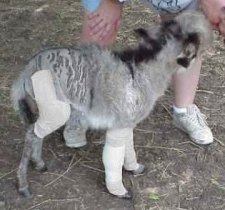Aggie is a miniature donkey jennet bred and owned by Lonnie and Brenda Short of Short Assets Ranch in Eddy Texas. At birth, her legs were crooked (from the way she was carried in the womb), so in order to have corrective surgery done, her long baby fuzz had to be shaved off. Only, the Shorts were not prepared for what lay beneath! When shaved, a pattern closer to a zebra than a donkey was revealed!

Brindle is a pattern fairly common in dogs (such as Boxers, Great Danes, some Corgis, even Pit Bulls), even cattle (Brahma), but rarely documented in equines. This great unknown is what prompted recent research into the brindle pattern by Sharon Batteate, herself the owner of a wildly popular brindle QH named “Brenda Batty Atty.” Sharon has a wonderful extensive website on this topic, complete with some of the best brindle patterned horses ever seen, in wonderfully full color! Brindle Website.
In all actuality, brindles have been documented for several hundred years, but the cases were so few and far between. It’s only been in recent times that serious breeding records have begun being kept on brindles (and brindle duns as well) to see if inheritance factors can be found. The pattern has shown itself among Warmbloods, Quarter Horses, Criollos, Arabs, Mustangs, TWH's, as well as other breeds. It’s even been known to crop up among Donkeys, and on occasion Mules. Many have just the double shoulder crosses, facial striping, and ladder marks, others the whole enchilada! Aggie’s markings go far beyond this. Even her collar buttons appear to have more of a line than a spot.
Now it should be mentioned here that occasionally horses that are striped can experience a strange phenonomen called "displaced striping.” This is just a misplacing of pigment cells during fetal development, and is not really related to the brindle pattern. However, these animals may only be striped on one side, whereas most true brindles have striping over the whole body. Dr. Phil Sponenberg, PhD, DVM looked over Aggie’s photos at the request of the ADMS registration office and agreed that Aggie appeared to be a true brindle.
Aggie’s legs are still a little crooked but much improved, and her owner reported that she’s spoiled and well loved. IF, in a few years, her vet thinks the little jennet can carry a foal safely without genetic risk, then she might go to the breeding shed. It would be VERY interesting to see if Aggie can pass on any portion of the brindle pattern. Neither of Aggie’s parents show any unusual striping at all. Her sire is a slate & white spotted donkey, her dam a typical solid slate grey. Future matings of this same pair might also be interesting to see if the pattern repeats itself or not.
We’ll keep you posted!
(This Page last updated: August 1, 2001)